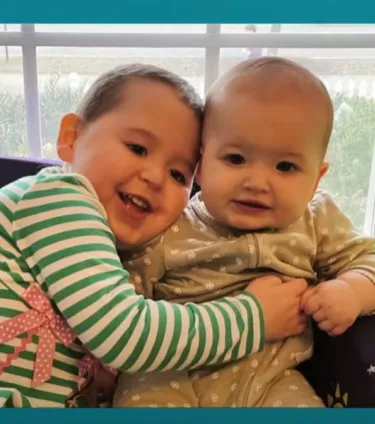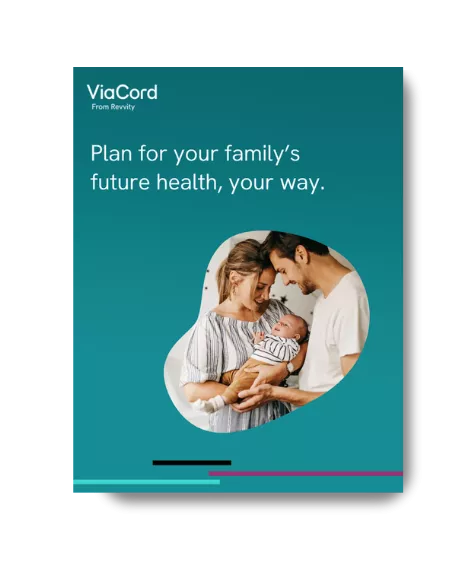COLLECTION TYPE:
Cord Blood Banking
Talk to a dedicated specialist
What is The Sibling Connection Program?
ViaCord’s Sibling Connection Program provides our high-quality cord blood collection, processing, and lifetime cord blood storage (78 years) at no cost to expecting parents who have a child with an established diagnosis that is currently treatable with a sibling cord blood transplant and meet the criteria and enrollment requirements of the program.
HERE FOR YOU
Nearly 10,000 families have joined our Sibling Connection Program
Download Our Brochure

Who's Eligible?
See if The Sibling Connection Program is right for your family
Full Sibling
The baby whose cord blood will be stored must be a full sibling (same biological parents) of the child in need.
Currently Treatable
The child in need must have a condition that is currently treatable with sibling cord blood in transplant. See Eligible Diagnoses below.
Eligible Diagnoses
Cancers
Acute lymphoblastic leukemia (ALL)
Acute myeloid leukemia (AML)
Biphenotypic Leukemia
Burkitt's lymphoma
Chronic myeloid leukemia (CML)
Chronic myelomonocytic leukemia (CMML)
Hodgkin's lymphoma
Juvenile myelomonocytic leukemia (JMML)
Lymphomatoid granulomatosis
Mixed Lineage Leukemia
Myelodysplastic syndrome (MDS)
Myelofibrosis
Non-Burkitt’s lymphoma
Non-Hodgkin's lymphoma
Bone Marrow Failure Syndromes
Amegakaryocytic thrombocytopenia
Autoimmune neutropenia (severe)
Congenital dyserythropoietic anemia
Congenital sideroblastic anemia
Cyclic Neutropenia
Diamond-Blackfan anemia
Dyskeratosis congenita
Evan's syndrome
Fanconi anemia
Glanzmann's disease
Kostmann's syndrome (severe congenital neutropenia)
Pure Red Cell Aplasia
Severe aplastic anemia
Shwachman syndrome
Thrombocytopenia with absent radius (TAR syndrome)
Blood Disorders
Click on the appropriate blood disorder to download the medical referral form.
E-β+ thalassemia
E-βo thalassemia
Sickle βo Thalassemia
Sickle-cell anemia (hemoglobin SS)
β-thalassemia intermedia
β-thalassemia major (Cooley's anemia)
Other Transfusion Dependent Sickle cell or Thalassemia
Metabolic Disorders
Adrenoleukodystrophy
Alpha mannosidosis
Fucosidosis
Gaucher's disease (infantile)
Gunther disease (congenital erythropoitic porphyria)
Hermansky-Pudlak syndrome
Hunter syndrome
Hurler syndrome
Hurler-Scheie syndrome
Krabbe disease (globoid cell leukodystrophy)
Lesch-Nyhan disease
Maroteaux-Lamy syndrome
Metachromatic leukodystrophy
Mucolipidosis Type II, III
Niemann Pick Syndrome, type A and B
Sandhoff Syndrome
Sanfilippo syndrome
Sly syndrome
Tay-Sachs Disease
Wolman Syndrome
Immunodeficiencies
Adenosine deaminase deficiency
Ataxia telangiectasia
Chronic granulomatous disease
Complete IFN-γ Receptor 2 Deficiency
DiGeorge syndrome
IKK gamma deficiency
Immune dysregulation polyendocrineopathy
Leukocyte adhesion deficiency
LRBA deficiency
Myelokathexis X-linked immunodeficiency
Omenn's syndrome
Reticular dysplasia
Severe combined immunodeficiency (SCID)
Thymic dysplasia
Wiskott-Aldrich syndrome
X-linked agammaglobulinemia
X-linked lymphoproliferative disease
X-linked Mucolipidosis, Type II
Download the Medical Referral Form
Other
Epidermolysis bullosa
Hemophagocytic lymphohistiocytosis
Juvenile Dermatomyositis
Langerhans cell histiocytosis
Osteopetrosis
HOW IT WORKS
Interested in Sibling Connection?
Here are next steps and what to expect . . .
- Talk your child's physician about The Sibling Connection Program
- If it's determined as an option, call our Sibling Connection Specialists 866-861-8435
- You and your doctor will complete our required enrollment forms (see below)
- Once approved, we'll send a ViaCord Collection Kit to your house and a letter to your delivering doctor
- Bring your kit to the hospital on the day of delivery and give it to the medical staff
- Remind your doctor that the cord blood being collected may be used by a sibling. Thoroughly cleaning the cord and collecting as much cord blood as possible are important.

REQUIRED
Enrollment Forms
Parent and Doctor forms must be completed and returned to ViaCord prior to enrollment. Send completed forms to siblingconnection@viacord.com or fax 1-781-240-8427.
SIBLING CONNECTION
Required Enrollment Forms For Parents
Parent(s) must complete all three forms for enrollment. The Health History Questionnaire is required should you need to use your newborn's stem cells.
SIBLING CONNECTION
Required Medical Referral Forms
Medical Referral Forms must be completed by the doctor caring for the sibling with the qualifying condition (the newborn must be a full sibling). Find the appropriate form below or from the Eligible Diagnoses list.













